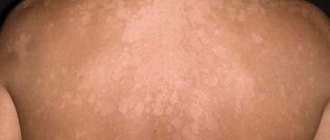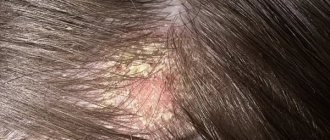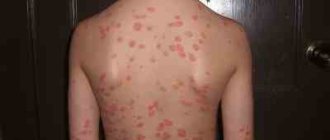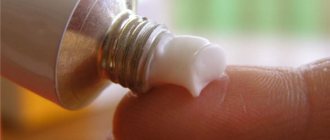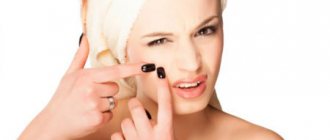Diagnosis by face
According to doctors, absolutely all human diseases in most cases are reflected on his face, so diagnosis by face is of great importance.
It is interesting that the face gives a signal when the disease is just beginning, that is, speaking in the language of doctors, it is still in its infancy. This means that by responding to this signal in time, you can prevent the disease.
The method of facial diagnostics, as well as methods of simple diagnostics of the body, was known in ancient times.
After all, all our organs have so-called areas of responsibility on their faces, certain changes in which with a high degree of probability can diagnose a clinical disease that has not yet manifested itself.
Diagnosis by face: eyes
If they are protruding or burning , there is a high probability that endocrine problems have arisen. Most likely, this is either Graves' disease or hyperthyroidism.
Red streaks indicate high blood pressure. Especially if this is combined with spots in front of the eyes or loss of visual fields. It can also be a symptom of extreme fatigue.
Swollen upper eyelids indicate renal failure, adenoids, and sinusitis.
The appearance of bags and dark circles under the eyes is a disease of the urinary tract, most likely the kidneys or bladder.
Shadows appearing are a sign of intoxication, which accompanies all chronic diseases.
Reddened upper eyelid – catarrh, inflammation of the gastric mucosa or gastritis.
Discharge in the corners of the eyes is a sign of a metabolic disorder; if the discharge is purulent, it is conjunctivitis.
Yellow sclera is a direct indication of liver failure.
Diagnosis by face: complexion
If there is a constant blush , for example dry, which is also called muted, this is most likely a sign of diabetes; if the blush is hot and bright, there are problems with the lungs, possibly tuberculosis. This blush appears on the cheek from which the disease in the lungs begins.
If yellowness of the skin , you need to know that this is a sign of the onset of hepatitis. Gallstone disease, that is, blockage of the bile ducts with stones, is also possible.
Pigment spots are evidence of liver disease and endocrine pathology.
Cuperosis - the appearance of spider veins on the cheeks - is a disease of the gallbladder and pancreas. The appearance of a pronounced capillary network on the cheeks indicates the onset of problems with blood vessels and developing hypertension.
Puffiness of the face is evidence of cardiovascular pathology and kidney disease.
Pale skin is a sign of anemia, called anemia.
Diagnosis by face: lips
If your lips are dry and chapped, this is a sign of gastritis or a stomach ulcer.
Dry lips – intestinal dysbiosis and decreased immune defense of the body.
“Balls” in the corners of the mouth indicate problems in the gastrointestinal tract. If they do not heal for a long time, this may be a sign of diabetes.
Pale lips are a sign of decreased pancreatic function, as well as heart problems.
Blue lips are a disease of the heart and lungs. This is called cardiopulmonary failure.
A constantly open mouth indicates nasal congestion. These are adenoids and sinusitis.
Diagnosis by face: acne (blackheads)
Acne or blackheads are small pimples on the chin that indicate hormonal problems. If they are on the forehead, this is a sign of colon disease.
Diagnosis by face: nose
If the nose is red and lumpy, with blue veins , this is a clear sign of a chronic disorder of the peripheral blood supply. This list can include alcoholism, atherosclerosis, and diseases of the cardiovascular system.
Diagnosis by face: hair
If the hair is brittle , it is a lack of metabolism or vitamin deficiency.
If your hair is oily and hangs like tow , this is a sign of endocrine problems and diseases of the stomach and intestines.
Athleticism.com.ua
Details 12715
Source: https://atletizm.com.ua/zdorove/diagnostika-organizma/202-diagnostika-po-litsu
What does the nose “tell” about?
If the nose has enlarged, a network of small vessels has appeared on its wings, the skin has become loose, and even purple in color - this is a signal that cannot be missed. A person begins to have serious problems with the lungs or large intestine.
You can often observe pronounced furrows running from the wings of the nose to the corners of the lips. This indicates that there has been a decrease in the functions of the gastrointestinal tract, and problems with food digestion have begun.
If the folds from the wings of the nose extend to the chin, then an urgent examination is necessary for the appearance of a stomach ulcer. This sign may indicate:
- for gastritis with high acidity,
- colitis,
- enterocolitis, as well as
- duodenal ulcer.
Wrinkles above the upper lip, which run parallel to the border of the lips, are a warning about possible gynecological ailments.
Why does blush appear on the cheeks?
There are many main reasons why cheeks are red. This:
- fluctuations in the emotional state (a person does not control these reactions, their manifestation is associated with the work of the autonomic nervous system, its sympathetic department);
- hormonal changes in the body (adolescence, menopause);
- taking medications (especially hormonal ones);
- alcohol consumption;
- in rare cases - liver or stomach diseases;
- allergic reactions;
- hypersensitivity and skin diseases.
Flushing, which externally manifests itself as red cheeks, causes stretching of the capillary walls and their thinning. As a result, blood stagnates in small blood vessels and produces harmful substances. Frequent redness of the cheeks leads to serious consequences - the development of rosacea. It is easy to identify it at home, but for treatment you need to see a doctor.
The child has
https://www..com/watch?v=ytaboutru
The baby's rosy cheeks delight parents and are perceived as an indicator of health; the pale skin of young children is more worrying. If your child’s cheeks suddenly turn red or this phenomenon occurs frequently, it may be associated with illness or the presence of a disease. Don’t worry right away if your child’s skin turns red due to certain factors:
- after playing in the cold, walking in the cool season (the blush lasts about half an hour after returning indoors);
- psychological reaction of the child (anger, shyness) - the redness will disappear when the child calms down;
- prolonged exposure to the sun;
- in children 1-2 years old, redness is observed after eating (especially in those who can eat on their own, the remains of some dishes cause irritation on the baby’s delicate skin).
There are reasons that should definitely alert attentive parents:
- red spots on the cheeks when the skin of the nose and the skin around the mouth turns red and burns when teething;
- redness of the entire face and chin - indicates dryness and high temperature in the room;
- red spots on a child’s cheeks, peeling, itching – appear due to diathesis and allergies;
- redness of a point nature, followed by the appearance of tubercles - may be an indicator of the presence of parasites in the child;
- red hot cheeks with pallor of the tip of the nose and lips, lethargy, poor appetite, cough, fever - sure signs of pneumonia;
- Red cheeks during night sleep are evidence of heart disease.
We suggest you familiarize yourself with Ointment for calluses and warts
In an adult
Redness on the cheeks of an adult becomes an indicator of serious diseases and allergic manifestations. This reaction occurs from several hours to several weeks. There are many reasons for redness: some are associated with genetic disorders, others are simple reactions to environmental influences. In some cases, the doctor recommends that the patient undergo blood and urine tests.
https://www.youtube.com/watch?v=5iqQgI8KGuc
Red skin on the cheeks is due to one of the reasons:
- blood flow during exercise;
- allergic reactions;
- hormonal changes;
- problems with the gastrointestinal tract;
- reaction of sensitive skin to the sun and wind;
- infectious diseases.
From a physiological point of view, adolescence is a difficult period. At this time, growth processes are actively launched, the sex glands begin to work, and hormonal levels change dramatically. The teenager’s body still needs to get used to the new substances that have appeared in his blood. Facial redness in adolescents may be associated with this. When hormone levels stabilize, the phenomenon disappears.
In addition, dysfunction of the cardiovascular system is observed in the body of a teenager. The heart grows faster than blood vessels, so it has to work harder.
In this regard, during adolescence, changes in blood pressure are observed, which can cause red skin on the cheeks.
When the processes of the final formation of the cardiovascular system are completed, such reactions stop.
However, people generally consider blushing to be a sign of shame, associated with confusion, embarrassment, lack of self-confidence, etc. Previously, shyness and modesty were considered a sign of good upbringing, so young girls were expected to blush with shame at the mere mention of men or obscenities.
However, blushing occurs in all age groups, not just teenagers and young adults. Most adults try to avoid situations that make them blush, because at that moment they feel uncomfortable and awkward. It seems to them that the appearance of blush indicates their lack of self-confidence and excessive shyness.
However, they blush not only from shame. Often a person can blush just at the mere memory of an unpleasant situation, when, for example, he found himself in a funny situation. Some people blush when they are praised or scolded, especially if this happens in public or if they value the opinions of those present.
We suggest you read about Red cheeks in an adult: causes - treatment
Allergy on the cheeks
There are many reasons for the appearance of allergic skin reactions that appear on the face in children and adults, these include:
- toxicosis in pregnant women;
- chronic infectious diseases;
- disturbance of intestinal microflora;
- unformed immune system;
- pet hair and skin/immune system reaction to it;
- cosmetics of dubious quality;
- contact with household chemical cleaners and detergents;
- carcinogens in food.
Allergic manifestations are not the only reactions of the body; the disease manifests itself in redness and rashes in other parts of the internal organs, inflammatory processes on the mucous membranes of the mouth, nose, eyes, enlarged lymph nodes, the appearance of signs of eczema, dermatitis. You definitely shouldn’t perceive red spots on your face as a harmless reaction or an aesthetic defect.
Fear of blushing (erythrophobia)
Experts call the fear of blushing erythrophobia. This fear is similar to stage fright, fear of public speaking, and other phobias. The more a person is afraid of blushing, the more often this happens, so you should not focus on this. Erythrophobia is an irrational fear that can turn into panic.
Psychologists suggest that there are many reasons for blushing and erythrophobia. They interpret blushing as an unresolved internal conflict. In this case, the person is unconsciously afraid that others will notice something that will make him feel ashamed and blush. At first, blush is only a somatic reaction of the human body.
How to reduce the appearance of blush?
You should not attach too much importance to the appearance of blush; this is the body's natural reaction to stress. Often people around you don’t even notice the blush, as it goes away quickly. If you have erythrophobia, autogenic training can help.
We suggest you read: Why does an adult’s head itch a lot?
Anyone can blush and, of course, such situations are not very pleasant for a person.
The fear of blushing becomes a phobia only when a person’s social behavior changes: he strives at all costs to avoid stressful and unpleasant situations, as a result of which the person’s social connections are disrupted. In this case, it is recommended to consult a psychologist or psychotherapist.
https://www..com/watch?v=ytpolicyandsafetyru
If a person’s face often turns red, then he should consult a psychotherapist. A specialist will help you find out the cause of this phenomenon.
During puberty, blushing is a fairly common occurrence, but it usually goes away over time (like age-related acne or voice mutation).
How to get rid
Redness on the cheeks cannot be ignored. If the blood vessels are close to the surface of the skin, any environmental influence causes the constant appearance of red areas; this manifestation does not require treatment. To stay outdoors, it is necessary to apply a protective composition.
If redness is associated with other diseases, such as cardiovascular diseases, appropriate therapeutic measures are prescribed that are aimed at eliminating the root cause. This applies to hormonal imbalances and treatment of dermatitis. Therapeutic measures should be prescribed by a dermatologist. When carrying out therapy it is necessary:
- stick to a diet;
- exclude certain foods;
- refuse cosmetic creams;
- forget about prolonged exposure to the sun;
- do not abuse alcohol.
Folk remedies
https://www..com/watch?v=ytadvertiseru
To treat redness of the skin on the cheeks, to eliminate other defects, it is good to wash your face with a decoction of chamomile, wipe the skin with an ice cube, and apply a care product morning and evening. In folk medicine there are a lot of recipes for tinctures and drinks; anyone can make them. They should help the body properly eliminate redness on the skin. Adviсe:
- Birch infusion lotions effectively solve the problem.
- It is good to use masks of sour cream, honey and olive oil.
- It is advisable to apply vegetable oils (sunflower, olive, etc.) to the skin of the face before going to bed.
Source: https://krasotka75.ru/pochemu-poyavlyaetsya-rumyanets-shchekakh/
Why is my left cheek burning?
When a person’s cheeks are burning, someone is definitely discussing it, but if the blush appears only on the left side of the face, the sign has a negative meaning. There are people around you who wish you harm.
Moreover, the most unpleasant thing in this situation is that they are part of the circle of your closest acquaintances, that is, you know them well and, perhaps, trust too much information.
The sign advises you to reconsider your surroundings and try to identify ill-wishers. It is quite possible that they are angry with you for a reason, but because of your own actions. Think about who you recently offended.
In this case, the likelihood of conflict is very high, especially if the left cheek burns strongly
Now it is important to control yourself and restrain your emotions. The best strategy is to be smarter and not follow the lead of provocateurs. If it was not possible to identify the enemy, do not despair: after some time the conspiracy will reveal itself
If it was not possible to identify the enemy, do not despair: after some time the conspiracy will reveal itself.
And remember, when your cheeks are burning, and you know exactly who is capable of harming you, this makes the situation much easier, since you understand who you are dealing with and what you can expect from this person. If it was not possible to identify the enemy, do not despair: after some time the conspiracy will reveal itself.
If the left cheek is burning, the omen has a negative meaning.
According to ancient legend, it is believed that a burning left cheek (namely the left one) is a bad sign, a negative omen. They talk badly about you “behind your back”; intrigues may be woven against you. But the most terrible thing, so to speak, is that all these “laces” can be created by relatives and friends (as you consider them) people! This is where it’s worth thinking about, perhaps reconsidering your social circle (close friends), and taking a closer look at your family.
You shouldn't trust people recklessly. Sometimes those closest to you betray, and in a very unexpected and unpleasant way. If your left cheek begins to burn, then you should not immediately suspect everyone around you or treat your family with disdain. You don’t know if they are really plotting something against you.
There are more detailed interpretations of signs that affect the gender and age of a person. The difference is considered to be significant, for example, if the phenomenon is disturbing:
- an unmarried girl who has a boyfriend in mind, which means he remembers her. The beloved thinks about his chosen one, says something good, praises her;
- an adult woman - she must be prepared for the fact that some sad event may soon happen that will quickly upset her, make her upset and worry. In this case, if she cries, the tears will remove all the negativity and protect her from future troubles;
- men and boys - in this case, they should immediately wash their face with cold running water, this phenomenon does not bode well for them. The sign indicates that problems at work will soon arise;
- child - he has been jinxed, the mother needs to wash him with water and wipe his face with the back of her hem.
Having understood what the burning of the left cheek portends, you need to immediately eliminate the phenomenon
It is important to understand that thoughts in the process of any action should only be positive. There is no need to endure it all day and wait for it to “go away on its own.” If only one cheek is burning, you won’t have to guess for long
“The left cheek is burning - someone is speaking evil” - this is folk wisdom
If only one cheek is burning, you won’t have to guess for long. “The left cheek is burning - someone is speaking evil” - this is popular wisdom.
If your left cheek burns very often, it means there are many envious people or ill-wishers in your environment. Think about your behavior and lifestyle. Try to “open up” to people less. Reduce communication with unpleasant people.
The blush on the cheeks is a sign of what?
Oddly enough, most often a blush on the face appears as a result of vivid emotional experiences, both negative and positive. An awkward situation or stress often causes a person to start blushing and cannot do anything about it. However, such a reaction does not last long. But what to do when the blush on your face is constantly present?
Blush as a sign of health
Many international clinical studies confirm the fact that a slight blush on the cheeks indicates good health.
Scientists start from the fact that the inner layers of our skin (dermis) are enriched with a large number of blood vessels that supply tissues with oxygen and nutrients, and also take away waste products of metabolism.
At the same time, the detection of excessive redness of the face of a local or widespread nature may indicate serious health problems.
How to treat?
Independent attempts to get rid of an unhealthy blush on the face often do not bring success. Nevertheless, in the first stages, especially if you know the probable cause of the skin reaction (for example, prolonged exposure to the sun or freezing), you can try protective medications in the form of creams, ointments, lotions, etc.
The most advisable thing is to visit a dermatologist to exclude or confirm skin pathology. If a skin disease is detected, a qualified specialist will prescribe appropriate treatment for you.
If you do not have skin problems, but the unhealthy blush on your face does not go away, we recommend that you consult a therapist for a full medical examination.
We strongly advise against using any traditional medicine recipes.
Self-treatment, as a rule, does not lead to anything good. Entrust your health to professionals who have sufficient experience and qualifications in their field of activity.
Source: https://elaxsir.ru/simptomy/drugie/rumyanec-na-shhekax-prichiny.html
The eyes can tell you about many health problems
If the skin at the inner corners of the eyes is blue or lilac, check your kidneys immediately.
The pupils of the eyes are often dilated - this is a warning about neuroses, problems of the nervous system, intoxication, mental disorders, perhaps the person is using drugs.
And constricted pupils signal intracranial pressure, excessive medication, drug use, thyroid dysfunction, even meningitis.
Convex, protruding eyes are a warning about hyperthyroidism.
Yellow whites of the eyes indicate an overload of the body with medications, liver dysfunction or hepatitis.
Continuous lacrimation indicates a lack of potassium in the body.
Persistent redness of the whites can be a sign of high intracranial pressure, intraocular pressure, retinal detachment, glaucoma, or extreme fatigue.
The sclera of the eyes with a bluish tint indicates a lack of vitamins and low hemoglobin.
Dear friends! Diagnosis of pathologies based on the face is not final. However, you can independently notice the first signs of an approaching illness.
Immediately report any warning signs to your doctor and get examined to rule out more serious illnesses. Every person should know how to identify a disease by looking at the face!
Blush on the cheeks: reasons. What does blush mean? The body's secret signals about illness
Many international clinical studies confirm the fact that a slight blush on the cheeks indicates good health.
Scientists start from the fact that the inner layers of our skin (dermis) are enriched with a large number of blood vessels that supply tissues with oxygen and nutrients, and also take away waste products of metabolism.
At the same time, the detection of excessive redness of the face of a local or widespread nature may indicate serious health problems.
Folk recipes for redness on the cheeks
Redness after allergies, chapping or sunburn may not go away immediately. Folk remedies will help ease your skin condition.
If there is redness, you should not carry out procedures to cleanse and tighten the skin, or wash your face with soap. This thins and further irritates the skin, making it sensitive and depriving it of nutrition.
As a cleanser, you can use an infusion of green tea, a decoction of chamomile or calendula.
To tone the skin and speed up the circulatory system, every morning you need to wipe the skin with an ice cube and then apply a nourishing or moisturizing cream.
Nutrition and restoration of skin with vitamin deficiency can be provided by special vitamin creams. They are very expensive in salons and pharmacies, but you can make such a cream yourself. To do this, you will need a simple moisturizer to which an oil solution of vitamin E is added (you can buy it at any pharmacy).
An infusion of birch buds will help speed up the disappearance of red spots. It will soothe and heal the skin. Lotions can be made several times a day by applying cotton pads soaked in the infusion to the stains.
Another popular remedy for red cheeks is garlic tincture. It helps with possible bacterial infections of the face. You need to take a half-liter jar and fill it three-quarters with finely chopped garlic.
The rest of the space is filled with alcohol, then the jar is tightly screwed on with a lid. You can use the product after infusing for 10 days in a dark place. People with sensitive skin and allergies should be careful with the tincture.
Masks based on sour cream and cottage cheese are suitable as an excellent nourishing and healing remedy for the face. They will help deal with blemishes and whiten the skin a little. As an addition to such masks, you can use olive oil and honey, infusions of herbs (parsley, chamomile) and egg white. For oily skin, you can use masks based on white clay with the addition of lemon juice.
A gentle blush has always been considered a sign of beauty. But if your cheeks often turn red and burn, then this is already a sign of problems in the body, which can be both physiological and psychological in nature.
However, people have developed their own interpretation of why cheeks are red and burning; there are a number of signs associated with this, which you can learn about on this site.
Signs do not appear just like that; they are usually the fruit of numerous observations that make it possible to connect one event or action with another and build a certain pattern.
So you shouldn’t look down on folk signs, especially since many of them are often justified.
But back to our question: why are your cheeks red and burning? By the way, in medicine this is referred to as blushing syndrome.
and has its own explanation.
Why do men and boys' cheeks burn?
Reducing the whole situation to signs - as if someone is discussing you - is a simple matter. The correct response to the question – why does a man’s face turn red for no reason – is not to engage in self-deception. There are reasons for your cheeks to burn, and they are too serious. One of the main reasons for men is facial redness after alcohol. Symptoms manifest themselves individually, the dose is different for everyone. Cheeks burn because alcoholic drinks provoke:
- increased blood circulation;
- violation of metabolic processes;
- allergy to alcohol ingredients;
- problems of the heart and blood vessels.
A smoker's face may burn, which is also associated with vascular impairment. Men are more likely to experience anger, which causes irritation of the sympathetic nervous system. The response is a sharp dilation of blood vessels and redness of the skin. The face is still burning:
- from heavy physical exertion - at work, when playing sports;
- work activity at low temperatures, in the heat.
Double interpretation:
- a guy, a mature gentleman in the thoughts of a young lady;
- misunderstanding with the superior, disciplinary action;
- the face turns red - women discuss a man - shortcomings and advantages;
- hot cheeks - signal the appearance of a new lover.
We suggest you familiarize yourself with Capsicum tincture for hair use



